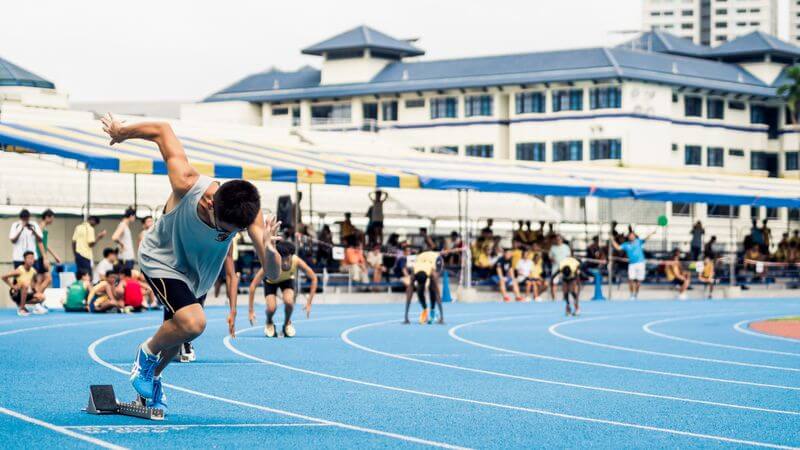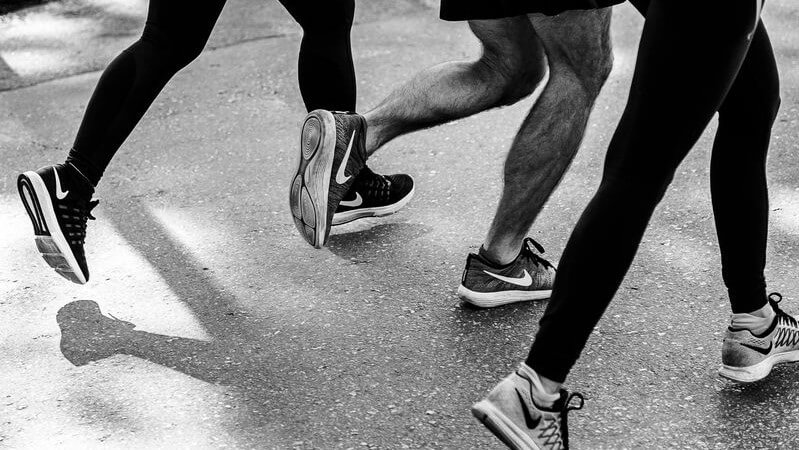Identifying ways to increase the efficiency of physical training has been a topic of interest for athletes and people seeking healthy lifestyles for years. With the global technology boom – and its impact on the fitness industry – the issue is equally relevant today. Although the benefits of training with haptic feedback, in particular, EMS and TENS, have been known for decades, this type of training is making big waves again with virtual reality and smart clothing gaining momentum.
Benefits of EMS used in physical training
What is the difference between EMS training and conventional workouts?
People are often skeptical of new technologies, but they are especially wary of complex ones. Figuring out what is the difference between EMS training and so-called voluntary training, with no appliances, is easy. One need only look towards our nervous system.
During voluntary training, the nervous system transmits electrical signals from the brain to the muscles, increasing the force that your muscles produce.

Electrical stimulation (ES) transmits mild pulses of electrical current to stimulate the nerves or nerve endings that in their turn innervate muscles beneath the skin. ES may be applied superficially on the skin (transcutaneously). This technology is called TENS (Transcutaneous Electrical Neural Stimulation). EMS (Electrical Muscle Stimulation) means that electrical pulses are transmitted directly into a muscle or a group of muscles to enhance their function. The principal difference between TENS and EMS for the end user is that EMS enables deeper impact and TENS provides for wider range of sensations, but softer ones than EMS delivers.
Going into further detail, when EMS is used the peripheral nerve is stimulated, which causes an excitation impulse that is transmitted along the nerve to the motor endplates in the muscle, producing a muscle contraction.
Currently, both EMS and TENS are used in rehabilitation therapy. Meanwhile, the research into the beneficial uses of EMS and TENS in physical training is still actively underway. Scientists are finding new specialized areas of application for these technologies all the time.
Below are some of the latest scientific articles on how electrical stimulation improves physical training.
Increase lean body mass, enhance extensor strength, and reduce body fat mass – it’s all about full-body EMS
In the study titled “The Effect of Electrical Stimulation in Improving Muscle Tone (Clinical),” M. F. Azman and A. W. Azman (2017) analyzed the ways patients with muscle atrophy benefitted from EMS. In the research, it was found that EMS “can promote and develop muscle bulk alongside continuous therapy.” The factors that can affect the speed of muscle development are the level of subcutaneous fat tissue, the electrode size, duration of therapy, and muscle condition.
Kemmler et al. (2017) in their study, the “Effects of Whole-Body Electromyostimulation versus High-Intensity Resistance Exercise on Body Composition and Strength: A Randomized Controlled Study” (2016) compare EMS training with high-intensity exercise. At the start of their 16-week long physical training study, the researchers divided the test subjects into two groups: one group used EMS for training, the other group practiced so-called “gold standard” high-intensity training. The main parameters used in the evaluation were the changes in lean body mass, leg-extensor strength, and total body fat mass.

The results of this experiment were a little bit unexpected. As shown in Table 4, it was determined that full body EMS was nearly equal to high-intensity resistance exercise in all compared indicators. Particularly, it was stated there was “no significant between-group difference” in terms of the results.
Thus, the authors concluded that “whole-body EMS can be considered as a time-efficient but priсey option to high-intensity resistance exercise for people aiming at the improvement of general strength and body composition.”
In another research article titled, “Whole-body electromyostimulation and protein supplementation favorably affect sarcopenic obesity in community-dwelling older men at risk: the randomized controlled FranSO study,” Kemmler et al. (2017) examine the same issues as the previous study but focus on a different target audience.
In this 2017 study, the participants of the survey were elderly men over 70 years with sarcopenic obesity. This body condition can be characterized by high fat mass and low muscle mass with low muscular strength or low physical performance. Sarcopenic obesity is a syndrome typical for older people who cannot exercise intensively.
The test subjects were split into 3 groups. The first used full-body electromyostimulation and took protein supplementation; the second group was only given the protein supplementation; the third was the control. The results of the research showed a significantly favorable effect of WB-EMS with protein. The most effective way to cope with sarcopenic obesity turned out to be full-body EMS with protein. This group indicated positive results in all respects: loss of body fat, an increase of skeletal muscle mass index, and greater handgrip strength. Along with this, no adverse effects of full-body EMS or protein supplementation were recorded.
Electrical muscle stimulation to perfect motor learning process
One of the latest scientific research studies on EMS motor learning is “Towards Amplified Motor Learning in Sports using EMS” (2017) by the German Research Center for Artificial Intelligence. This work compares two approaches to coaching for running.
The goal of coaching runners is to train them on effective and safe running practices in order to improve their performance. When runners use the wrong running technique, for example striking the ground with their heel first, they can cause injuries. That’s why it’s important to practice mid- or forefoot running to reduce impact loads. Most people, both amateurs and professionals, are used to running in their own style, and it is always more difficult to retrain than to learn new things.

One approach to training used in their study was showing the runners slow motion videos and accompanying them with verbal instructions. Another one involved wearing electrical muscle stimulation appliance and an insole with force sensing resistors. The device analyzed the user’s running stride pattern and in the vent of the wrong foot angle before landing, it provided real-time feedback via EMS.
The second type of coaching proved to be more efficient than the traditional method. EMS helped the runner intuitively. These results had longer impacts as even after disabling the EMS actuation, the runners had lower heel strike rates.
Thus, the study revealed that EMS is an effective tool for motor learning of complex, repetitive movements. Also, the researchers mentioned that similar training can be applied to other sports like cycling, rowing, and climbing.
EMS for recovery
As a recovery tool EMS carries out four key functions:
- enhancing blood circulation and oxygen and nutrients being delivered to muscles and other soft tissues;
- muscle activation to contribute to preparation for training or/and competition;
- improvement of muscle elasticity;
- controlling muscle soreness and pain relief after training.
One of the latest research studies that confirmed all of the above was “Electrical Muscle Stimulation as an Effective Recovery Modality” (2015) by Derek M. Hansen, which was included in the report “New Studies in Athletics” by the International Association of Athletics Federation. EMS has been recognized as an effective recovery method as part of combination recovery and regeneration therapy after training. Particularly, when combined with massage, contrast baths, stretching, and other recovery activities, electrical muscle stimulation can accelerate recovery and prepare the athlete for the next workout. Besides, when an athlete does not have enough time for recovery, EMS can serve as an alternative to the conventional recovery process.
TENS: training for rehabilitation and pain relief
The American Heart Association showed that transcutaneous electrical nerve stimulation (TENS) used along with task-oriented training enhances motor function after stroke in their research study: “Bilateral Transcutaneous Electrical Nerve Stimulation Improves Lower-Limb Motor Function in Subjects With Chronic Stroke: A Randomized Controlled Trial“ (2018).
Also, the rehabilitation properties of TENS were explored in the study “The influence of Task-Related Training combined with TENS on paretic upper limb muscle activation in patients with chronic stroke” (2017). The study demonstrated greater improvement in muscle activation after task-related training with transcutaneous electrical nerve stimulation.
Another scientific work, “The Effectiveness of Transcutaneous Electrical Nerve Stimulation in Knee Osteoarthritis with Neuropathic Pain Component: A Randomized Controlled Study” (2017), reveals that TENS therapy can significantly relieve pain, decreasing drug dosage, and improve physical function.

Let’s sum up the possible results of ES application in physical training:
- motor learning of complex movements;
- acceleration of recovery as part of combination therapies;
- muscle activation;
- pain relief;
- increased lean body mass;
- reduced body fat mass;
- decreased drug dosage in the rehabilitation process.
Motion capture in physical training
Motion capture is the process of digitally recording people’s movements. Numerous research studies have shown that motion capture (mocap) can help in not only conventional teaching and training methods but also improving trainees’ cognitive abilities and capacity to assess their own performance, skill to implement effective teaching management and organization. Therefore, adding motion capture technology to training provides a better environment for training.
In particular, in the scientific work “An Optimization Method of Basketball Teaching and Training System Design based on Motion Capture Technology” (2017) by Shandong Normal University, it was revealed that 3D simulation technology can assist basketball players in learning the technical basis of action faster, reduce repetition blindness, and noticeably improve training efficiency. Moreover, scientists claim that motion capture can help to reduce the possibility of athlete injury.
One more research study “Development of a system for supervised training at home with Kinect V2” (2016) that was carried out by University of Applied Sciences Technikum Wien showed that a motion capture provided a high level of motivation for injured athletes who were part of a rehabilitation program.
A prototype for rehabilitation under supervision is equipped with Kinect v2. The principle of action is the detection of the whole body position. If the exercise is not properly performed (any joint angle is not correct), the system doesn’t count this repetition. This sequence is repeated until a certain number of repetitions is fulfilled. This system can be applied to all exercises with different levels of difficulty.
When the user does not perform an exercise correctly, a video demonstration is played in the corner of the screen.
This training process is designed based on gamification concepts in order to help the user to maintain motivation, which is extremely important while training at home. And, of course, the platform records the training process and allows the user to compare performance data, such as time, points, length, and so on.
Similarly, motion сapture is an effective method of risk-management in physical training. In their 2017 article, “Automated Quantification of the Landing Error Scoring System With a Markerless Motion-Capture System” (2017), the National Athletic Trainers’ Association (USA) found evidence that an automated markerless motion-capture system is reliable in assessing lower extremity movement and helps to identify the risk of noncontact lower extremity injuries. Individual rehabilitation programs can be developed in a way that minimizes the risk of injury by using data provided by the mocap system. Subsequently, such an approach to training and rehabilitation can improve the overall health of the user in the long term.

Let’s summarize what benefits motion capture system can bring during physical training:
- teaching the underlying technique of various exercises;
- improving training efficiency using visual feedback and comparison with the standard;
- risk-management in physical training (reduce the possibility of injury);
- providing motivation through gamification and feedback.
Microclimate influence on human wellbeing during physical training
Microclimates can have a significant impact on the human body. All life processes in the body provide energy for motor activity. A small percentage of that energy is expended in the performance of useful work, but most is converted into thermal energy. This continuous release of heat into the environment ensures the normal course of physiological processes.
For vital processes to occur in the body, there must be an allocation of heat emitted by the body to the environment or protection of the body from excessive heat release to the external environment. Deviation from microclimate parameters leads to a heat imbalance.
The effect of low temperatures on the body
Rapid temperature reduction can lead to excessive supercooling. When the body is cooled excessively, the functioning of human organs and the rate of biochemical processes decreases. Even with the short-term effect of cold on the body, the regulatory and homeostatic systems are restructured and the immune status of the body changed.
Cooling, both general and local (especially of the hands), contributes to a change in this motor reaction, disrupts coordination, impedes the individual’s ability to perform precise operations and causes inhibitory processes in the cerebral cortex. The latter can be cause of injury.
When the body is placed under this stress, the individual’s attention is diminished, mental activity is inhibited, and activity and efficiency decrease.
The effect of high temperatures on the body
High temperatures have a negative impact on human health too. Training in conditions of high temperature are accompanied by intense sweating, which leads to dehydration of the body, loss of mineral salts and water-soluble vitamins, causes serious and persistent changes in the activity of the cardiovascular system, increases respiratory rate, and also affects the functioning of other organs and systems—attention is weakened, coordination deteriorates, reactions become slower, etc.
Of course, forced training in warm or hot conditions can be especially unpleasant. This is particularly true as it concerns outdoor training, training in hot summer periods or in areas with hot climates.
Exercising in the heat can result in early exhaustion or even heat-related illnesses. This fact is confirmed in the book “Body Temperature Regulation During Exercise Training” (2016) by Kazunobu Okazaki. While thermoregulatory function depends on individual somatotype, fitness level, and physiological status, as mentioned by the Swedish public health agency in the thesis “Comparing air quality in a training facility,” the average temperature of an individual “should be between 20-23°C to not experience discomfort.”
Thus, training in uncomfortable conditions can reduce an individual’s efficiency and motivation. In Suleyman et al.’s article “Associations between Thermal and Physiological Responses of Human Body during Exercise” (2017), there is a correlation between thermal comfort and rating of perceived exertion. That is to say, the lower the thermal comfort, the more exhausted the participants felt. It was also found that the more physical fit the participants, the less affected by temperatures.
The study “Consensus recommendations on training and competing in the heat” (2015) shows that cooling may help recovery from intense exercise in heat-stress. Moreover, in some cases, cooling may improve performance in subsequent intense training sessions. Also, the research asserts that in professional sports, the athlete ideally needs 14 days to acclimatize using a comparable degree of heat stress as the target competition.

Garments with climate control
Smart garments with thermal changes allow the user to control and monitor the clothing’s internal temperature from low temperatures to high temperatures, depending on the situation and needs of training. Providing the most comfortable conditions for the user’s smart garments can also bring benefits such as increased mobility.
There are smart garments on the market that can both cool and heat. They are based on the thermoelectric effect with embedded Peltier elements. It’s a smart heat exchange technology that creates instant coolness or warmth when needed while guaranteeing long-lasting comfort. Smart tech features improve and accelerate the thermal energy exchange between the body and the textile, allowing redundant heat to be instantly dissipated or stored based on the wearer’s temperature.
In physical training, these smart suits can be used to monitor the temperature, humidity of the patients during training. Suits can also be used for elderly people who are susceptible to temperature change. Likewise, soldiers faced with extreme temperature conditions (both hot and cold can benefit from these versatile garments.
The advantage of cooling garments before and/or during exercise
Cooling garments such as ice-cooling jackets have an advantage in comparison with other methods of cooling such as cold-water immersion and others. Cooling garments reduce skin temperature without reducing muscle temperature, so athletes can wear them during warm-up or recovery breaks. Furthermore, according to research results in “Consensus recommendations on training and competing in the heat” (2015), reducing an athlete’s body temperature during training lowers their cardiovascular strain.
Biometrics in physical training
Biometric data can be divided into 2 main types: physiological and behavioral (behaviometrics). The former category is related to the body, the latter is connected with behavioral patterns.
At the current stage of technological development, physical training is more closely associated with physiological characteristics. Smart clothing is particularly apt for tracking an individual’s physical state. Close to the body smart garments with invisible sensors allow for comfortable control of performance and health. In addition, feedback from data analytics provides the user with a health forecast and helps them to avoid injury.
Here are the advantages that smart garments can offer to the wearer:
- flexibility;
- wireless connection;
- a large surface (body) for reading out data;
- freedom of movement;
- invisible sensors (others may not even realize that you are wearing smart clothes);
- all-in-one solution (opportunity to implement numerous sensors for different types of data);
- analyzes the performance of various sports and exercises;
- offers optimal physical activity;
- forecast possible overload or injury;
- relatively / potentially low-cost fabrication.
Electrocardiography (ECG)
Electrocardiography is the process of recording the electrical activity of the heart during a certain period of time by means of electrodes placed on the skin.
TESLASUIT with electrodes tracks the user’s heartrate and views real-time ECG with great precision. In so doing, most normal ECG can be filtered out, and the ECG abnormalities are able to be analyzed in the cloud.
The features of this suit have several practical applications. First, this function is relevant for people with heart diseases and elderly people. Secondly, the feature is suitable for professional athletes for load control. And finally, this feature is useful for people who practice a healthy lifestyle and wish to monitor their heart health.

Galvanic skin response (GSR)
Galvanic skin response is one of the most representative characteristics of emotional arousal. It’s related to electrodermal activity (EDA) or skin conductance (SC). But GSR is actually the underlying cause of electrical characteristics of the skin.
EDA controls the amount of sweat secretion from sweat glands. Skin conductance is also related to emotional arousal. The higher the arousal is, the higher skin conductance will be.
Both electrodermal activity and skin conductance are not under our control. Therefore, GSR provides an indication of the emotional state, which has visual expression and can be quantified. Thus, GSR is an index that gives a strong signal of not only the physiological but also the psychological processes of the human.
And in this, GSR gives really impressive results in combination with other types of biometric data: ECG, EEG, EMG, EEG, eye tracking, analysis of facial expression, etc. By embracing an integrated approach, behaviors driven by emotion can be tracked.
Thus, tracking GSR allows the user to select an appropriate load, contributing to their psychological comfort during physical training.

Electromyography (EMG)
Electromyography (EMG) is a method for evaluating and recording the electrical activity by skeletal muscles. The measured EMG signal covers various types of data regarding the nervous system, e. g., muscle movement and muscle fatigue. That is why it entails pre-processing depending on the purpose.
For example, “A Study on EMG-based Biometrics” (2017) by Chosun University in Korea demonstrates that EMG data showed the motion recognition performance of 95%.
In addition, applying EMG in sports may improve training especially in helping users to detect errors as a result of underlying muscle tension. This finding was backed by the 2016 article “Using Electromyography for Improving of Training of Sport Shooting”. In the experiment conducted by IFAC (International Federation of Automatic Control), EMG was used successfully to improve users’ shooting skills.
Moreover, training with electromyography is an effective method of rehabilitation for stroke patients. Ju-Hong Kim in “The effects of training using EMG biofeedback on stroke patients upper extremity functions” (2017) showed that electromyography biofeedback training had a beneficial effect on stroke patients’ upper limb functions.
SpO2
SpO2, the saturation of peripheral oxygen, is the key indicator of oxygen saturation levels.
Maintaining the levels of SpO2 within the normal range contributes to more efficient training. The lungs’ ability to deliver oxygen throughout the body is increased, influencing muscle function, blood pressure, and metabolism.
Skin temperature
There is a correlation between an increase in the skin temperature and muscle activation. The temperature rises in the areas next to the muscles involved in the motor activity. It’s a consequence of increased metabolism as a result of training one’s muscles.
Through biometrics data, we can gain a wider picture of your overall health, optimizing the load, allowing you to maintain a balance between performance and wellbeing.
In summary, smart clothing technologies serve as an important opportunity for the improvement of physical training at different levels—whether professional sports or rehabilitation. Motion capture enables a deeper analysis of the performance technique. Electrical stimulation allows for an increased load. Finally, climate control and biometrics tracking allow the user to control the process of training to make it both comfortable and effective.
